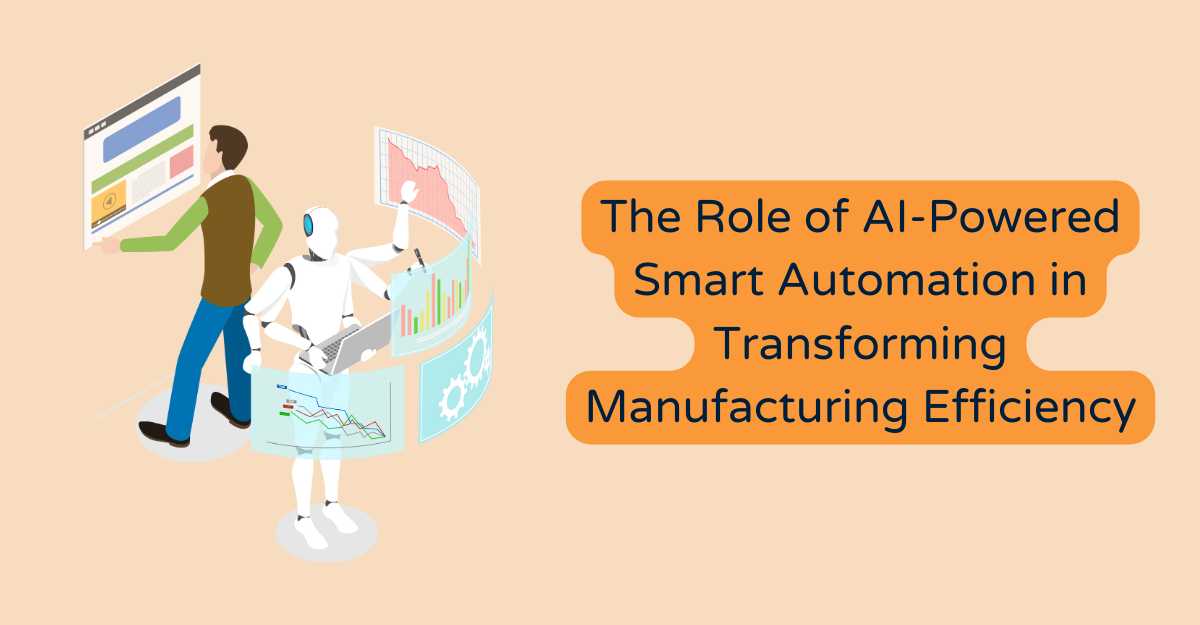
Picture a sleek robotic factory. New robots roll down lines to start work. Advanced computers predict supply issues. They spot problems early and solve them beforehand. Moreover, defect detection camera vision guides quality testing automatically.
Welcome to the era of smart manufacturing that is taking the world by storm.
In 2023, the worldwide smart manufacturing market saw significant growth, reaching an estimated value of $108.9 billion. Looking ahead, experts anticipate this market to continue its upward trajectory, projecting it to reach $241.0 billion by 2028. This marks a remarkable compound annual growth rate (CAGR) of 17.2% over the forecast period.
In this blog post, we will delve into the exciting realm of smart automation and its role in driving manufacturing efficiency to new heights. We will also delve into the importance of operations marketing professionals in this domain.
Understanding AI-Powered Smart Automation
Smart manufacturing systems incorporate advanced technologies that enable automated processes to take charge. Driven by algorithms, these systems allow production workflows to improve and optimize unaided over time.
Such automated set-ups aid data inputs, identify effective strategies, and perform procedural tasks on a large scale with high repetition. This reduces the necessity for direct human oversight during operations.
This section explains their applications and how automation systems integrate innovative, self-adjusting technical built-ins.
Intelligent Logistics Coordination
AI-powered predictive analytics integrate live GPS tracking of inbound supply trucks with dynamic ETA modeling. This system incorporates current traffic conditions, weather forecasts, and historical data to predict the arrival times of materials.
Consequently, warehouse labor and inventory stocking systems can be scheduled with precision based on this information.
Rather than relying on static schedules that cause overstaffing or material shortages when delayed, smart systems effortlessly calibrate just-in-time logistics through status alerts, preventing snarls.
Prescriptive Maintenance Algorithms
By monitoring vibration, temperature, and other sensors on critical equipment components, machine learning models profile normal performance patterns.
These models then detect emerging deviations indicative of impending breakdowns. Combining predictive maintenance analytics with automated work order generation and parts reordering dramatically minimizes downtime from mechanical failures. This keeps production humming 24/7.
AI-Based Learning Control
High-resolution computer vision camera systems fueled by deep learning neural networks train an innate ability to spot intricate product defects throughout the manufacturing progression.
This autonomous quality management platform achieves near-perfect detection rates at faster speeds by screening items for common anomalies in shape, consistency, or packaging.
Smart machines enable smart factories. Yet driving adoption relies on smart leaders – skilled in emerging technology while adept at influencing teams through change.
As automation redefines operations, demands for management professionals grow. Blending data analytics, AI systems grasp, and organizational impact unlocks success. Moreover, advanced degree programs develop this in-demand digital operations dexterity.
The Growing Need for Advanced Operations Expertise
Innovation teams are currently focused on refining predictive algorithms and enhancing robotic precision. Amidst this technological advancement, the role of a technology-to-business translator becomes vital.
This individual is tasked with informing investment trade-offs and maintaining work culture buy-in throughout the transitional period. Kettering University highlights that these professionals play a critical role in implementing necessary upskilling strategies to support the workforce during these transformative years.
Operations managers gain coveted status as factories digitize. Blending statistical and data science skills with leadership fluency, these professionals ably bridge physical and digital workflows.
Masters in Operation Management(MOM): Connecting Dots
An operations management master’s degree focuses on developing rare and sought-after skills in optimizing automation, metrics modeling, and strategic adoption techniques.
This prepares them to lead initiatives in managing robotics deployments, VR control procedures, rapid prototyping systems, and other aspects of autonomous manufacturing upon entering the workforce.
These individuals are the decision-makers who drive manufacturing transformations by guiding equipment investments and fostering change adoption through analytical modeling and team motivation, essential in today’s tech-driven era.
Strategic Oversight Optimizes Adoption
The positive ROI from AI-powered automation relies heavily on operational leaders overseeing integration aligned to long-term production strategies rather than siloed technology upgrades in the absence of ecosystem coordination.
Masters of Operation Management (MOM) professionals bridge between physical equipment investments and multi-layered process transformations involving control algorithms, mobile interfaces, data lakes, and beyond—guiding stakeholder journey mapping while tracking capability utilization analytics to inform necessary policy changes.
Infrastructure Powers Algorithmic Value
As manufacturing data grows rapidly, outdated systems hold back valuable insights. Futureproofing IT architecture and designing role access with automation can unlock fuller intelligence. This granular visibility enables proactive decisions based on material flows and demand patterns, which were previously impossible.
Targeted Maturity Drives Efficiency Gains
Management experts stress the importance of phased automation focused on addressing specific pain points systematically, supported by change adoption frameworks that address cultural transitions.
Sustainable outcomes are achieved through gradual progress rather than radical transformation attempts. However, realizing these possibilities requires credible expertise and patience.
Real-Life Applications
Here are two examples of potential optimizations enabled by aligning automation execution with operational analytics.
Optimizing Asset Utilization: Automakers are using smart technology like computer vision and sensors to track how well their machines are being used in production. By analyzing data on things like machine uptime and speed, they can find and fix problems that slow down production.
Optimizing Quality: Automation in 3D printing uses computer-controlled systems to streamline the printing process, reducing manual intervention. It optimizes tasks like material loading and part orientation, improving efficiency and print quality.
By automating repetitive tasks, it boosts productivity and enables printers to operate autonomously for longer periods.
In conclusion, while the market is rapidly advancing toward digitalization, the fundamentals of operations remain crucial. Leaders, people, and workflows must align closely to leverage emerging technologies in modern manufacturing strategies effectively.
Moreover, as the manufacturing landscape evolves, companies must also prioritize continuous learning and adaptation. Investing in employee training and upskilling programs ensures that teams remain equipped to navigate the complexities of new technologies and processes.
By fostering a culture of innovation and agility, organizations can stay ahead of the curve and drive sustainable growth in the dynamic marketplace.

